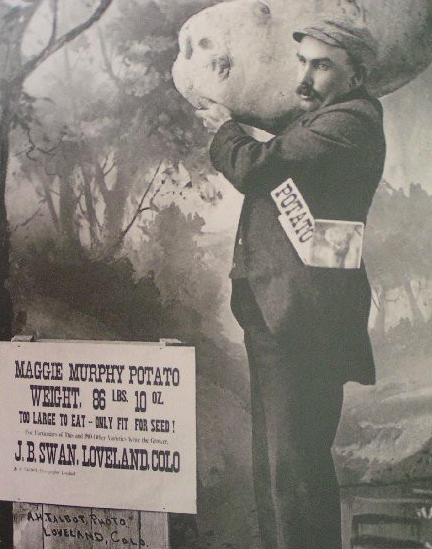R. A.
The words “mammoth” and “potato” do not often go together. But in 1894, W. L. Thorndyke, a news reporter in Loveland, Colorado, decided to help a man named Joseph B. Swan. Swan was a farmer from outside Loveland who was looking to promote his farm. Thorndyke and Swan decided to enlist the help of Adam H. Talbot to capture a photograph that would do just that. The photograph that they created depicts a very large potato on Swan’s shoulder. This photo did not take long to circulate. An editor who thought it was funny first picked it up, then many more followed. Today, this photograph is considered to have possibly been the first viral photograph.
The phrase “less is more” does not usually apply to the size of produce. This is based in a cultural construct, which associates large produce with good farming. The lengths that Swan went through to create this fake photograph show just how true this generalization is. In the beginning, he never intended for people to even believe that his picture was real. He simply wanted to use this understanding people already had of large produce to his benefit. However, once the photo started circulating it was hard to stop people from this misinterpretation. It was inevitable that people would think it was a real potato especially, because something like this had never been done before. Lots of people asked for parts of the potato or seeds so they could grow their own. Some even wanted to put the potato on display. When people came to his farm and asked about the mammoth potato he would initially tell them the truth of the advertisement. However, he later claimed that it had been stolen, and he did not know where it was. Whether this was to save his pride in not actually having such a large potato or simply laziness at retelling the story so many times is hard to tell. This is true of many circulating viral photos even today. Once it gets out of hand in this way it is hard to stop the ideas of the general public, and it is often easier to go along with their outrageous beliefs.
Americans continue to obsess over the size of things in the twenty-first century. For the most part these encounters are solely for the sake of humor. For example, a Pinterest page shows a collection of people with giant dogs. There are so many different iterations of the photo that they must have copied one another. In this there is a desire to join in on the entertainment. This shows just how willing people are to participate in the absurd. In this regard, Americans are quite similar to how they were in 1894. We want to be there when something interesting happens. However, this response is different from how people participated in the potato hoax. In 1894 people wanted to possess the potato. In 2019 people hope to perpetuate the same hoax.
In the twenty-first century, viral photographs are even more shocking. From pictures of a shark attacking a helicopter to giant animals, this trend did not end with Swan and his potato. There is something to be said about the importance of a photograph to public interest. In the case of Swan, the photo pertained to social constructions of what it means to be a good farmer. Because of this, his photo aimed to show something about his character as a farmer. It can still sometimes be the case that the goal of a fake photo is to engage people through a relevant cultural understanding. However, more often, fake photos now are simply outrageous and have no message other than promoting a response. The difference is that now the response is generally irrelevant to day-to-day life. This results in the current public being desensitized to viral photos. It is hard to fully participate because of their frequency.
These photos have a negative cultural impact. As a whole Americans have continued to show a desire to participate in even ridiculous activities for entertainment. Fake viral photos have become more frequent. These photos have desensitized the American public to the fact that so much media consumption is not real. Often, it is hard to even acknowledge the viral fake photographs because of how widespread they are. The internet has perpetuated the circulation of false things in general. In this case, it has made viral photos more common and as a whole less interesting. What would have caused people in the nineteenth century to travel or at least write to someone now barely prompts any response. This has consequences for how Americans view the world. Not responding makes it easier for fake viral photos to be taken for truth.
